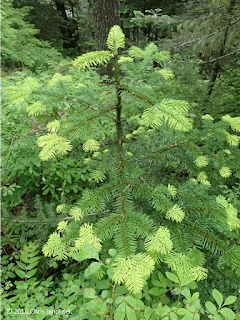Last week was my first visit to Mt.
Rainier National
Park in central Washington .
The peak at the center of the park is the highest mountain in the Cascade Range , rising above 14,000 ft. The park boasts
lush temperate rainforest and wide river washes fed by rain and glaciers
crowning the mountain.
 |
| Vine maple, Acer circinatum, the foliage of which is just delightful in the fall. |
Waterfalls dot the Rainier map and we headed towards Comet Falls Nisqually River
that eventually runs into the Nisqually Delta near Olympia . The creek water rushed through a
narrow channel of bedrock in a precipitous drop through a small valley making
its way down the mountain. After crossing via foot bridge, the trail runs along
the eastside of the creek up the slopes of Rainier .
The water’s roar was a companion during the hike.
Flowers increased in number and variety gaining elevation up
the trail. Among the most common were white six-petaled blooms of Clintonia uniflora, the flowers emerging
not far above the ground next to a pair of smooth spatulate leaves (not unlike
commercial orchids). Another frequent small ground cover species with white
blooms was Cornus unalaschkensis (a
small relative of the much larger tree, the dogwood). Yellow asters which I did
not observe closely enough to attempt to identify were also common.
 |
| Blooms of Cornus unalaschkensis (left) and Clintonia uniflora (right), both common near Comet Falls. |
Near Comet Falls there was a small population of the striking
avalanche lily, Erythronium montanum,
which I would later see in greater abundance in the higher elevation meadows at
Paradise farther up the slopes Mt. Rainier . The
flowers of this species hang down towards the ground, having six somewhat dishelved
white petals that radiate out from a bright yellow center. Paradise
also had many individuals of another species of fawn lily, E. grandiflorum (the Glacier lily), similar to the avalanche lily
in habit, but with solid yellow flowers. E.
montanum is distributed in the Pacific Northwest while E. grandiflorum occurs from British Columbia
to California and into the Rocky Mountain
 |
| Avalanche lily. |
 |
| Comet Falls. |
There were a few Columbia
tiger lilies along the trail too. Other booming species were numerous and included
Maianthemum racemosum (large false
Solomon's seal), Rubus parviflorus
(thimbleberry), Rubus spectabilis
(salmonberry), Rubus lasiococcus
(dwarf bramble), Corallorhiza mertensiana
(western coralroot), Phyllodoce
empetriformis (pink mountain heather), Dodecatheon
sp. (shooting star), and the striking red and yellow ornate flowers of Aquilegia formosa
 |
| Coralroot (Orchidaceae). |
The rainforest at the base of Mt. Rainier Pacific Northwest 's,
massive conifers dominate the canopy. Cedars and firs were common in the park,
and I also noted western hemlock, mountain hemlock, and Douglas fir. The new
growth of needles on the tips of the conifer branches was everywhere, the
bright green centimeters of vibrant new growth giving accent to the deeper
evergreen of the older growth, such a pleasant sight! Lichens hung from the
trees in abundance, giving the landscape a depth of age too.
After hiking to Comet
Falls , we camped that evening among
the beautiful conifers and had one more day to explore Mt. Rainier
References
Baldwin et al. 2012. The Jepson Manual. Higher Plants of California . 2nd
edition. University of California Press, Berkeley , CA
Turner M, Gustafson P. 2006. Wildflowers of the Pacific Northwest . Timber Press, Portland , OR
 |
| New growth on a small fir tree. |
No comments:
Post a Comment